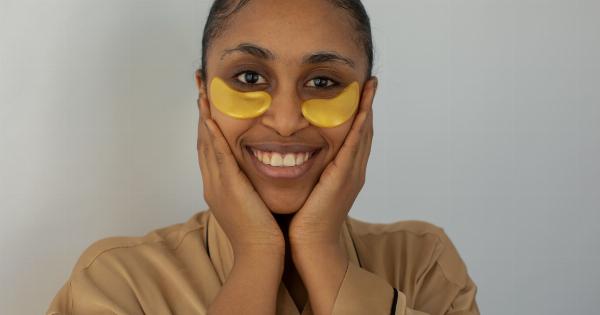Eye barley, a common condition known medically as hordeolum, is a painful and annoying inflammation of the eyelid. It occurs when one or more oil glands in the eyelid becomes infected, usually due to the presence of bacteria.
While eye barley can be uncomfortable, the good news is that there are several effective remedies and preventive measures you can take to say goodbye to this pesky condition once and for all. In this fast and simple guide, we will explore the causes, symptoms, treatments, and preventive tips for dealing with eye barley.
What Causes Eye Barley?
The primary cause of eye barley is the presence of bacteria, specifically Staphylococcus aureus, on or around the eyelid.
This bacterium is commonly found on the skin and can easily make its way into the oil glands of the eyelid, leading to an infection. Other factors that can contribute to the development of eye barley include:.
- Poor eyelid hygiene
- Using dirty or contaminated cosmetic products
- Wearing contact lenses for extended periods without proper cleaning
- Sharing makeup or cosmetic tools with others
- Weakened immune system
- Stress or fatigue
Recognizing the Symptoms
Eye barley typically manifests as a small, painful bump on the eyelid, resembling a pimple or a boil. The most common symptoms associated with this condition include:.
- Tenderness and swelling of the eyelid
- Redness and warmth around the affected area
- A sensation of grittiness or the presence of a foreign object in the eye
- Increased tearing or watering of the eye
- Mild to moderate pain or discomfort
It is important to note that eye barley should not be confused with a chalazion, which is a painless, non-infectious swelling of the eyelid caused by a blocked oil gland.
While barley and chalazion may appear similar, they have different causes, treatments, and outcomes.
Treatments for Eye Barley
Fortunately, there are several effective treatments available for eye barley. Here are some of the most commonly recommended options:.
1. Warm Compresses:
Applying a warm compress to the affected eye can provide immediate relief by promoting circulation, reducing swelling, and speeding up the healing process.
Simply soak a clean cloth or cotton pad in warm water, wring out the excess, and gently press it against the closed eyelid for 5-10 minutes, several times a day. Make sure the water is not too hot to avoid burns.
2. Antibiotic Ointments or Drops:
If your eye barley does not subside within a few days or if it is significantly impacting your daily activities, your doctor may prescribe antibiotic ointments or drops to help clear the infection.
Apply the ointment as directed by your healthcare professional, making sure to maintain proper hygiene during application.
3. Avoid Eye Makeup:
To prevent further irritation and potential contamination, it is best to avoid using eye makeup until the infection has completely cleared up. Cosmetics can introduce additional bacteria and slow down the healing process.
Remember to discard any makeup or brushes that may have come into contact with the infected eye.
4. Good Eyelid Hygiene:
Practicing good eyelid hygiene is crucial for preventing future occurrences of eye barley. Keep your eyelids clean by gently washing them with a mild, hypoallergenic cleanser or baby shampoo diluted in warm water.
Use a clean cotton pad or your fingertips to cleanse the area, making sure to rinse well and pat dry.
5. Avoid Touching or Rubbing Your Eyes:
Touching or rubbing your eyes can not only exacerbate the symptoms but also spread the infection to other parts of the eye or even to your other eye.
Avoid touching your eyes with dirty hands and try to resist the urge to rub or scratch them, as difficult as it may be.
6. Consult a Healthcare Professional:
If the symptoms persist or worsen despite trying home remedies, it is important to consult a healthcare professional. They can assess your condition, provide a proper diagnosis, and recommend appropriate medical treatments, if necessary.
Preventing Eye Barley
“Prevention is better than cure” holds true for eye barley as well. While some factors contributing to eye barley are beyond our control, there are several preventive measures you can take to reduce your risk of developing this condition:.
1. Maintain Good Eyelid Hygiene:
As mentioned earlier, keeping your eyelids clean and free from bacterial buildup is crucial. Regularly wash your eyelids with a gentle cleanser and avoid using dirty towels or washcloths.
2. Avoid Sharing Personal Items:
Sharing personal items like towels, washcloths, makeup, or contact lenses can increase the chances of bacterial transfer and infection. Keep your personal hygiene items separate and avoid sharing them with others.
3. Replace Eye Makeup Regularly:
Eye makeup, particularly mascara and eyeliners, should be replaced every three to six months to minimize the risk of bacterial contamination. Avoid using expired or old makeup products.
4. Practice Proper Contact Lens Hygiene:
If you wear contact lenses, make sure to follow proper hygiene practices. Clean and disinfect your lenses as directed, and avoid wearing them for longer periods than recommended. Replace your contact lens case regularly to prevent bacterial growth.
5. Boost Your Immune System:
A strong immune system can help fight off infections more effectively. Maintain a healthy lifestyle by eating a balanced diet, exercising regularly, getting enough sleep, and managing stress.
6. Avoid Eye Irritants:
Avoid exposing your eyes to irritants like smoke, dust, and allergens, as they can cause inflammation and increase the risk of infection. Wear protective glasses or goggles if necessary.
7. Be Mindful of Touching Your Eyes:
Try to avoid touching your eyes unnecessarily. Scratching or rubbing your eyes can introduce bacteria and potentially lead to infections.
Say Goodbye to Eye Barley for Good!
By following the remedies and preventive tips outlined in this fast and simple guide, you can effectively say goodbye to eye barley. Remember to practice good eyelid hygiene, avoid sharing personal items, and be mindful of potential irritants.
Should you experience recurring or severe eye barley, it is always best to consult a healthcare professional for proper diagnosis and treatment. With a little care and attention, you can keep your eyes healthy and free from eye barley!.




























